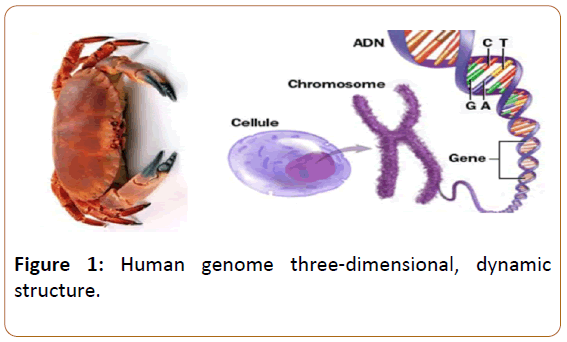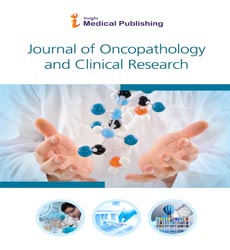All of The Cancer is Genetic, But They Are Not Hereditary
Hasibe Vural Cingilli*
Department of Medical Biology, Meram Faculty of Medicine, Necmettin Erbakan Unversity, Konya, Turkey
- *Corresponding Author:
- Cingilli HV
Department of Medical Biology, Meram Faculty of Medicine
Necmettin Erbakan Unversity
Konya, Turkey
Tel: (+90)3322236654
E-mail: hcvural@gmail.com
Received Date: February 22, 2018; Accepted Date: March 24, 2018; Published Date: April 05, 2018
Citation: Cingilli HV (2018) All of the Cancer is Genetic, but They are not Hereditary. J Oncopathol Clin Res. 2:4.
Editorial
The meaning of the cancer term refers to as crabs. After clamping the enemies crab clutching their long gear lever and slowly gnaw eats. If it left untreated in people gradually weaken debilitating human and eventually kills therefore, this disease is called cancer (Figure 1).
Human Genome three-dimensional, dynamic structure controls the activity of the adjustment mechanism and regulates gene in different layers. Until recently, protein encoded by only 2% for the majority non-functional, so as not a static password genome that is considered unnecessary, has a depth and complexity than expected. Genome by epigenetic mechanisms transmitted from generation to generation is therefore sensitive to environmental factors. Today, we are in a position to elaborate the human genome, geneticists and molecular geneticists working.
Looking back a history filled with success. If we look forward to a more promising hope this situation will always be waiting for us. Genetic changes that cause hereditary diseases in the 1980s, beginning with identifying mutations of knowledge and new technologies, human genetics has completely changed the discipline. Especially in understanding the etiology of inherited diseases with Mendelian rules for years, running from success to success in human genetics discipline, even in the 2000s, it has entered a different period after the completion of the Human Genome Project, dizzying advances in genetics in recent years, not only fundamentally affect the practice of medicine and has shown that it is also about our DNA structure of common diseases, which is the main cause of death of man, This new information changed the entire paradigm in biology.
We work with groups of diseases usually the differences in metabolic mechanism, genetic predisposition and disruption of key genes in cellular signaling mechanisms such as failure or unlock or consist of a plurality of different types of cancers and type encountered by the effects of environmental agents. About 10% is transmitted by the Mendelian inheritance of these diseases, we call connection are sporadic and 90% complex form of inherited.
Because cancer is a disease of the genome, the main problem beginning with structural changes in DNA is uncontrolled proliferation. Most of the deaths in the tumoral tissue itself is not cancer, as cancer is caused by the growing secondary metabolic changes. These changes cell proliferation and life, and relationships with adjacent cells arises from the modifications of the capacity control mechanism evade the immune system.
Three main rules must be violated for the development of cancerous cells. The first of these rules are divided only in accordance with signals from the cell. Violation of this rule is stimulated by a hormone or growth factor, the cells are normally activated by the circuit, it is closed by again. Another rule encounters abnormal conditions of the cells, instead of starting apoptosis of damaged DNA replication genes to activate. the cells to escape apoptosis have normally needed to prevent the mechanism which prevents excessive cell division. This mechanism is regulated by two major genes. These genes are the TP53 gene and retinoblastoma/Rb gene. This mutation cells become ineffective when the two mechanisms simply divided, however, as they escape from apoptosis and thus begins the formation of tumorous tissue.
The latter is of a limited division of normal cells. Normal cells are divided into a predetermined number because telomeres at the ends of chromosomes. Telomeres are DNA composed of a split away again. Telomeres have lost their property after repeated cell division takes the form of bits old cells. Telomerase in cancer cells allows for the elimination of adding new divisions feature repeats to chromosomes and divide the cell is programmed for a much longer period. In addition, cancer cells in live tumor as well as changes and evolves in nature. To understand how this process works, it will help us combat the cancer early. Because tumor cells in cancer undergo different mutations like the branches of trees.
Our research to understand these diseases at the molecular level, it is more complicated to solve our estimate of the genetic structure. We have seen recently, cellular damage caused by mutations aims to find effective molecular pathways and lighting. However, it will open the way for a long time understood by the expected treatment. The most important treatment for the development of individualized treatment will first need to increase awareness and understanding. Because we better understand the molecular behavior of cancer, cancer care treatment offers the opportunity for individuals with special approach. Genomic approach to work with all genes in the human genome, its interaction with the other of each of the genes, environmental, including the interaction with psychosocial and cultural factors. The purpose of functional genomics; the expression of genes, shape, quantity and the understanding of the organism found in addition to examining the functions of genes in genome level in terms of time and help. Also today; the most common causes and forms among the cancer of human death and disease, diabetes, we see that the most widely sold them when we look at drug or features that molecule with a specific protein targets or protein function for the treatment of heart and circulatory disease. Scientific developments in the field of proteomics, eventually with very few side effects, but are believed to allow more individualized drug useful in the development of contemporary research; and it focused on research on this family of proteins involved in the mechanisms of emergence of similar diseases.
When on the basis of diseases, especially cancer, as well as environmental and genetic structure thought to the behavioral characteristics based on genomic data, environmental and behavioral factors with socio-demographic characteristics and evaluating the work of constructing the project. In this context, following the close of medicine in the future determination of the mode of inheritance of individual risk factors accordingly individuals will be able to formulate the factors shaping it. Especially for cancer patients with a particular disease to help individuals with specific medical practices may fail to prevent the spread of the disease from generation to generation. These practices should certainly be supported, but in a way the future is unknown consequences of this practice. Now we balanced the human body, nature provides healthy conditions in a way he cannot rely on nature, we also organize regular or unmutated will be protected, we cannot guarantee the healthy gene from generation to generation. In fact, there are only individual patients and their existence will define the future of human conditions. In my opinion the future is a complementary approach to specific individuals’ evolutionary medicine and medicine exactly this situation will contribute to the development of the individual specific medicine. All work like I did with my studies research group should be supported by OMIC approaches.
Open Access Journals
- Aquaculture & Veterinary Science
- Chemistry & Chemical Sciences
- Clinical Sciences
- Engineering
- General Science
- Genetics & Molecular Biology
- Health Care & Nursing
- Immunology & Microbiology
- Materials Science
- Mathematics & Physics
- Medical Sciences
- Neurology & Psychiatry
- Oncology & Cancer Science
- Pharmaceutical Sciences

